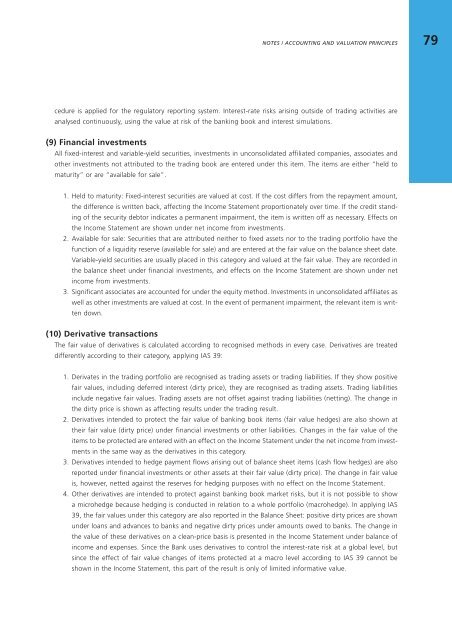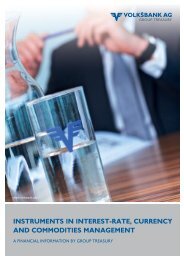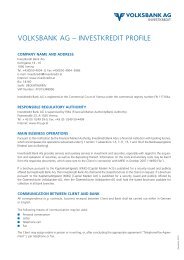Download (2.2 MB) - Volksbank AG
Download (2.2 MB) - Volksbank AG
Download (2.2 MB) - Volksbank AG
You also want an ePaper? Increase the reach of your titles
YUMPU automatically turns print PDFs into web optimized ePapers that Google loves.
NOTES / ACCOUNTING AND VALUATION PRINCIPLES<br />
cedure is applied for the regulatory reporting system. Interest-rate risks arising outside of trading activities are<br />
analysed continuously, using the value at risk of the banking book and interest simulations.<br />
(9) Financial investments<br />
All fixed-interest and variable-yield securities, investments in unconsolidated affiliated companies, associates and<br />
other investments not attributed to the trading book are entered under this item. The items are either “held to<br />
maturity” or are “available for sale”.<br />
1. Held to maturity: Fixed-interest securities are valued at cost. If the cost differs from the repayment amount,<br />
the difference is written back, affecting the Income Statement proportionately over time. If the credit standing<br />
of the security debtor indicates a permanent impairment, the item is written off as necessary. Effects on<br />
the Income Statement are shown under net income from investments.<br />
2. Available for sale: Securities that are attributed neither to fixed assets nor to the trading portfolio have the<br />
function of a liquidity reserve (available for sale) and are entered at the fair value on the balance sheet date.<br />
Variable-yield securities are usually placed in this category and valued at the fair value. They are recorded in<br />
the balance sheet under financial investments, and effects on the Income Statement are shown under net<br />
income from investments.<br />
3. Significant associates are accounted for under the equity method. Investments in unconsolidated affiliates as<br />
well as other investments are valued at cost. In the event of permanent impairment, the relevant item is written<br />
down.<br />
(10) Derivative transactions<br />
The fair value of derivatives is calculated according to recognised methods in every case. Derivatives are treated<br />
differently according to their category, applying IAS 39:<br />
1. Derivates in the trading portfolio are recognised as trading assets or trading liabilities. If they show positive<br />
fair values, including deferred interest (dirty price), they are recognised as trading assets. Trading liabilities<br />
include negative fair values. Trading assets are not offset against trading liabilities (netting). The change in<br />
the dirty price is shown as affecting results under the trading result.<br />
2. Derivatives intended to protect the fair value of banking book items (fair value hedges) are also shown at<br />
their fair value (dirty price) under financial investments or other liabilities. Changes in the fair value of the<br />
items to be protected are entered with an effect on the Income Statement under the net income from investments<br />
in the same way as the derivatives in this category.<br />
3. Derivatives intended to hedge payment flows arising out of balance sheet items (cash flow hedges) are also<br />
reported under financial investments or other assets at their fair value (dirty price). The change in fair value<br />
is, however, netted against the reserves for hedging purposes with no effect on the Income Statement.<br />
4. Other derivatives are intended to protect against banking book market risks, but it is not possible to show<br />
a microhedge because hedging is conducted in relation to a whole portfolio (macrohedge). In applying IAS<br />
39, the fair values under this category are also reported in the Balance Sheet: positive dirty prices are shown<br />
under loans and advances to banks and negative dirty prices under amounts owed to banks. The change in<br />
the value of these derivatives on a clean-price basis is presented in the Income Statement under balance of<br />
income and expenses. Since the Bank uses derivatives to control the interest-rate risk at a global level, but<br />
since the effect of fair value changes of items protected at a macro level according to IAS 39 cannot be<br />
shown in the Income Statement, this part of the result is only of limited informative value.<br />
79









